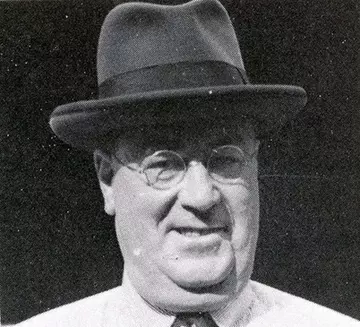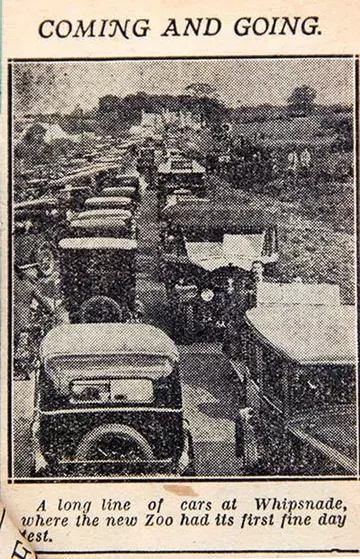
Guest blog by ZSL library volunteer, Beryl Leigh
In ZSL’s Archives there is a wealth of unpublished information about animals and ZSL, the ‘Daily Occurrences’ are an important example. They are a fascinating continuous record for both ZSL London and Whipsnade Zoo - recording on a daily basis animal arrivals and departures, visitor attendances and works being carried out on both sites. ZSL is keen to make these more widely available, particularly as they are primary source material for historians. With this in mind Library Volunteer, Beryl Leigh, generously funded the scanning of a few keynote volumes of the Occurrences. This allows people around the world to view these few volumes without the need to actually visit ZSL Library & Archives in London.
To set the scene
It’s a cold and frosty start to the year, and entries to the daily log are largely about construction works. Despite the frost, new animal enclosures, public walkways and shelters, foundations for the car park, refreshment kiosks and toilets, as well extensive landscaping and gardens, are being prepared.
The 500-acre Hall Farm estate on Dunstable Downs near Whipsnade was purchased by ZSL in 1927 and work is proceeding on the development of a Zoological Park. Public opening is scheduled for the Whitsun Bank Holiday weekend in May. Sir Peter Chalmers Mitchell has been ZSL Secretary since 1903, when he first proposed the idea of acquiring a country estate to complement the city zoo at Regent’s Park. ZSL Council eventually agreed to go ahead with the project in 1926.
The Duke of Bedford, President since 1899, provided invaluable support, contributing many of the animals and many ornamental trees. Dr Geoffrey Vevers, Zoo Superintendent at Regent’s Park since 1923, took residence at Whipsnade in November 1930 to oversee preparations for opening day. He signs off each page of the Daily Occurrences.
Plans for Whipsnade Park
From the start, and as set out in the Zoological Society of London Act 1928, Whipsnade was planned as a Park for the breeding and exhibition of wild animals and as a British nature reserve. The ZSL Annual Report for 1930 notes:
‘Great care is being taken to make it a sanctuary for British wild bird and the flowers, trees and shrubs natural to the region. It is hoped that it will attract not only those interested in animals but the even greater number of the public who take pleasure in the beauties of rural England.’ The emphasis given to this aspect of the project might seem a bit surprising but reference to it appears in the Occurrences throughout the year. Nature notes from Dr Vevers are frequent – ‘red squirrel seen’ on 9th January, ‘observed 6 crossbills’ 15th January, ‘cuckoo heard’ 22nd April.
A special note on 22nd January records that ‘12 species of British terrestrial orchids have been planted in Wood Lawn, Cut Throat Wood, Whipsnade Wood and on the Downs below the Fellows Pavilion and Triangle Kiosk’. Managing Whipsnade Park as a nature reserve was always going to be a tall order, given the growing herds of grazing animals and numbers of visitors to the Park. However, this ambition does recognise the importance of Whipsnade’s ancient chalk grassland. Since the 1980s, an area of this rare habitat near the White Lion has had SSSI status (Site of Special Scientific Interest).
Much of the heavy work is completed by mid-February 1931. From the Departures note on 22nd February we learn that ‘The numbers of the unemployed which have been working on roads and chalk pits during the past year were reduced from 150 to 40 men’. Under a Ministry of Labour scheme to address the lack of jobs in recession-hit areas, unemployed Welsh miners and others were offered work at Whipsnade. The Society was required to provide accommodation and pay 25% of their wages.
As the weeks go by more animals are purchased or transferred from Regent’s Park and there are further contributions from the Duke of Bedford – flamingos, partridges, geese, wallabies, a camel and a zebra to name just some.

In the first week of May Captain William Beal, formerly the Principal Veterinary Officer of the Gold Coast, starts work as the first Whipsnade Superintendent. He is one of the great Whipsnade characters, and he will remain in this job until 1947. From 7th May he takes over the role of signing off the Daily Occurrences.
There is 7-day a week working in the run-up to opening day in order to complete work on animal paddocks, the restaurant, refreshment kiosks, car park, turnstiles, sign boards, rain shelters etc. Arrivals from London Zoo on 14th May include an elephant and two lion cubs. On 17th May the Arrivals are Regent’s Park office staff who have a picnic and no doubt test the facilities! There is a Press day and then on Friday, 22nd May (in rain) a Private View day for dignitaries and ZSL Fellows. Last-minute work is still going on in the restaurant and on telephone lines.
Opening Day
Whipsnade Park opens to the public on Saturday 23rd May. Admission is one shilling for adults and sixpence for children; parking fees are one shilling for cars, sixpence for motorcycles and two pence for cycles. The charge for a horse vehicle is also sixpence, but a ‘representative of the owner must be left in charge of it’, so a boring day for someone! Not only does the car park have petrol pumps, there’s also a staff mechanic on hand to help with overheating engines and other minor repairs. The Hall Farm restaurant serves hot lunches, teas and 3-course dinners into the evening. There’s a Fellows’ refreshment Pavilion and four other refreshment kiosks for the public, all fully licensed.
Despite dull, wet weather on opening day, there are 1,080 visitors, £95-2s-0d is taken on the gate and £4-16s-3d by the car park. Whit Sunday is far busier, 10,000 visitors, but nobody is prepared for what happens on Bank Holiday Monday. The PR work and advertising pays off, it’s a fine and sunny day, and Whipsnade is completely overwhelmed with 26,946 visitors (and all food and beer had been consumed by midday!). Over £1,900 is collected in entrance tickets and parking.

As the Morning Post reports the next day – ‘WHIPSNADE BESIEGED. Overwhelming rush of people to the new open-air zoo. Traffic facilities break down. For the first time for many years, railway bookings from London were suspended by order of the police authorities.’
The Occurrences on 26th May note that work starts on a second car park entrance and restaurant alterations continue. But the truth is that an immediate and major rethink is necessary. Bear in mind that up to this point the business plan for 1931 has been based on an estimated income (excluding catering profit) of £2,500 for the whole year.
The Catering Manager, now a desperate man, needs a bigger restaurant, more seating and facilities at the kiosks, extra summer workers and more accommodation for them. Sir Peter Chalmers Mitchell and Dr Vevers have been invited (perhaps summoned) to a meeting at the Ministry of Transport with local County Council chiefs to discuss plans for improving access to the Park and parking. It is now clear that a considerable amount of extra expenditure will be required to facilitate the smooth running of the Zoological Society’s second zoo.
If you would like to view the scanned Daily Occurrences they can be accessed via our online catalogue http://library.zsl.org simply type ‘Daily Occurrences’ into the search box. If you would like to use the original volumes please do make an appointment to visit ZSL Library & Archives and let us know which volume(s) you would like to consult. They are not on open access in the Library and so we need advance to notice of visits to make use of them.
Reference list
Zoological Society of London Act 1928. Chapter xliii London: HMSO
ZSL Annual Reports, 1930 and 1931
London Zoo and Whipsnade Committees (Minutes)
The first meeting of the Whipsnade Committee is on 10th June 1931.
Guide to Whipsnade Zoological Park / by Sir Peter Chalmers Mitchell 1st edition, May 1931
Centenary history of the Zoological Society of London / by Sir Peter Chalmers Mitchell London: ZSL, 1929
London’s Zoo: an anthology to celebrate 150 years of the Zoological Society of London / compiled by Gwynne Vevers London: Bodley Head, 1976
Whipsnade Wild Animal Park: my Africa / by Lucy Pendar Dunstable: Book Castle 1991 There is also an interview with Lucy in Paul Wilson’s blog about Whipsnade
At Whipsnade zoo: with a wallaby guide / by Gladys Davidson London: Thomas Nelson, 1934 See the Acknowledgements on page vii for the note about Spens Steuart.
Love thy neighbour, Wild About, Spring 2019, pp 38-39
